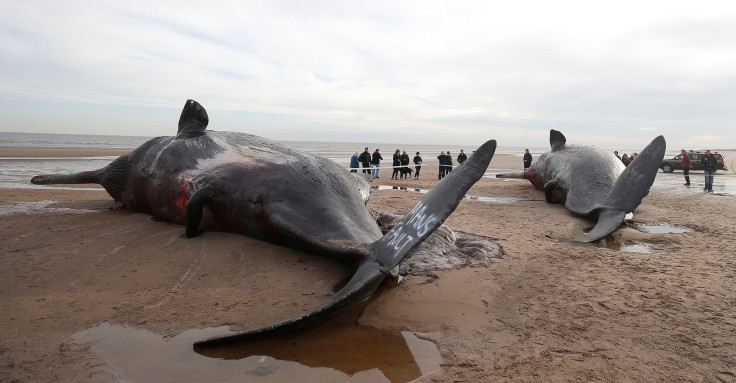Intense Solar Storm Coming For Earth May Cause Auroras, Beached Whales

Things might get weird on Earth over the next few days, following some intense solar activity.
Even though the sun is reaching the point in its 11-year cycle of activity during which it is supposed to have the least activity, NASA’s Solar Dynamics Observatory spotted solar flares this week that were some of the most powerful possible and sent radiation shooting toward us. The sun also burst out with coronal mass ejections, streams of particles that can gush in the direction of Earth. Both of these kinds of discharges can wreak havoc on our satellites and have other effects on our planet.
On Wednesday, the space agency reported, the sun erupted in a solar flare shortly after 5 a.m. EDT and then again around 8 a.m., with the SDO capturing images of both. The flares were ranked in the X-class, the most intense class of solar flares.

The first flare was labeled as an X2.2, in which the number further measures strength. The second reached X9.3, meaning it was about four times more intense than the first.
“The X9.3 flare was the largest flare so far in the current solar cycle, the approximately 11-year-cycle during which the sun’s activity waxes and wanes,” NASA said. “The current solar cycle began in December 2008, and is now decreasing in intensity and heading toward solar minimum. This is a phase when such eruptions on the sun are increasingly rare, but history has shown that they can nonetheless be intense.”
Those two came a couple of days after a solar flare on Sept. 4 that was a mid-level flare, in the M-class. NASA rated it as an M5.5 flare, explaining that the M-class represents flares that are “a tenth of the size of the most intense flares, the X-class flares.” It came from the same region as the ones that burst on Sept. 6.

The Space Weather Prediction Center within the National Oceanic and Atmospheric Administration has put a watch in effect for a “strong geomagnetic storm” between today and Saturday, warning that the material from coronal mass ejections are scheduled to arrive at Earth. The center was forecasting a 75 percent chance of a minor radio blackout and an 85 percent chance of a solar radiation storm. According to the SWPC, satellites in low-Earth orbit might experience more drag and have to be reoriented, and there could be issues with satellite and low-frequency radio navigation.
There might be a more visual consequence: auroras. The center said with strong geomagnetic storms, which are labeled “G3” on NOAA’s space weather scale, auroras have been spotted as far south as Illinois and Oregon, even though it is typically a phenomenon seen only at the more northern latitudes, toward the poles.
All these effects come when the charged particles and radiation from the sun’s ejected material reach Earth and interact with the electronics in space and with our planet’s magnetic field.
The highest level of a geomagnetic storm is a G5, at which point there are severe and widespread problems with power grids, intense satellite disruption and navigation systems knocked out for hours or days.
It’s possible that there will be ecological consequences with the coming geomagnetic storm as well. A group of scientists reported this month their theory that geomagnetic storms can cause whale strandings, because whales have a magnetic sense that helps them navigate and solar eruptions can interfere with Earth’s magnetic field. In their research, the team was using 29 incidents from last year in which sperm whales became stranded in shallow water, washing up on the shore and dying. Those whale strandings coincided with solar activity that affected Earth.
One of the researchers, Klaus Vanselow, told International Business Times that it’s possible migrating whales like sperm whales and pilot whales could be affected by the geomagnetic storm taking place over the next few days.
During his research, the whale victims were all male and most were young, so they did not have as much navigational experience as others, particularly up north where geomagnetic storms are felt more intensely — hence why auroras tend to appear closer to the poles than to other latitudes.
But other circumstances may have to come together with the geomagnetic storm to cause the whales to wash up.
“Environmental and biological factors can support strandings,” Vanselow said. “I think stress is a good factor for mis-navigation,” including disruption from ships, noise and plastic pollution. “In the past I found over 30 strandings theories and a combination of different factors is thinkable. I think it is a wide field of research, and not solved until now.”

© Copyright IBTimes 2024. All rights reserved.





















